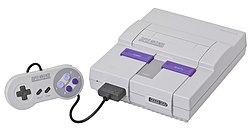Super Nintendo Entertainment System
The Super Nintendo Entertainment System (often shortened to SNES or Super NES) is a 16-bit video game console created by Nintendo, released first in 1990. It is the successor to the NES. It was called the Super Famicom in Japan, and the Super Comboy in South Korea. The console can display 2D graphics, with some limited support for 3D graphics with the Super FX chip. Super NES games are loaded from a cartridge. The major competitor for the SNES was the Sega Genesis/Mega Drive, but it also competed with the TurboGrafx-16, the Neo Geo AES, and the Panasonic 3D0.
 | |
 | |
| Manufacturer | Nintendo |
|---|---|
| Type | Home video game console |
| Generation | Fourth generation |
| Release date | November 21, 1990 August 23, 1991 April 11, 1992 July 3, 1992 |
| Units sold | 60 million UK, US & Canada |
| Media | Pictures, Videos, Music |
| CPU | Nintendo 32 bit CPU card |
| Storage | cartridge |
| Controller input | 2 controllers |
| Connectivity | No connectivity |
| Online services | Satellaview (Only in Japan) |
| Backward compatibility | No compatibility |
| Predecessor | Nintendo Entertainment System |
| Successor | Nintendo 64 |
Notable games
- Super Mario World
- Super Castlevania IV
- Super Mario RPG: Legend of the Seven Stars
- Super Metroid
- Donkey Kong Country
- EarthBound
- The Legend of Zelda: A Link to the Past
- Super Mario Kart
- Super Mario World 2: Yoshi's Island
- F-Zero
- Star Fox
Super Nintendo Entertainment System Media
The Super Famicom, a video game console released by Nintendo in 1990. The 16-bit follow up to the successful Famicom, and it became the highest selling console of its generation, selling close to 50 million systems worldwide. Worldwide, the system was known as the Super Nintendo, and in the North American markets it received a boxier, purple redesign.
S-CPU, the main CPU of the SNES, a Ricoh 5A22
Top: North American cartridgeBottom: Japanese/PAL Super FX-enhanced cartridge






